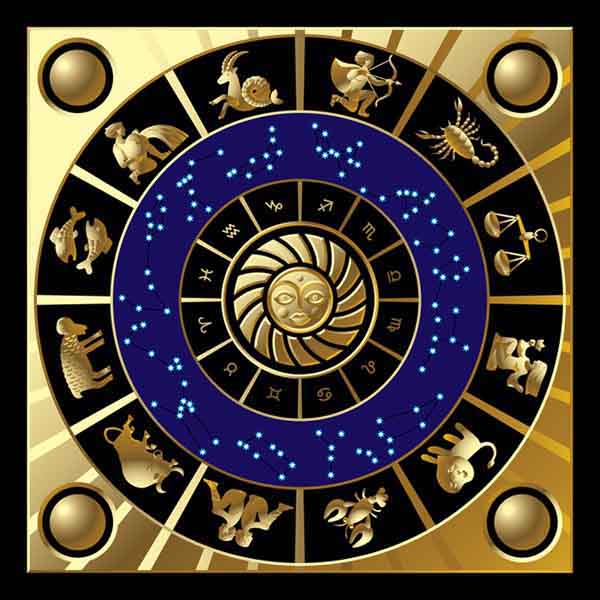

�Jyotisha (Vedic) is the Hindu system of astrology, one of the six disciplines of Vedanga. The Sanskrit word derives from jyotis which means "light, brightness", but in the plural also "the heavenly bodies, planets and stars". Jyotisha thus signifies the "science of heavenly bodies".
Jyotish is often discussed as the instructional element of the Rig Veda, and as such is a Vedanga, or "body part" of the Vedas. Jyotish is called the Eye of the Veda, for its believed ability to view both phenomenal reality and wisdom itself. Part of a larger Vedic curriculum including mathematics, architecture, medical and military applications, it superficially has much in common with ancient and modern Western astrology (and the early traces of the descent of various schools of astrology from the Harappan and Egyptian cultures, Chinese and the Chaldean, through the Arabs, Greeks, and early Romans show complex interweavings that are assessed variously by diverse camps of scholars -- who, however, currently find little common ground as to the exact historical development).
Jyotish has many facets, and some of its basics are clearly also cornerstones of Western astrology, such as symbolically endowed signs, houses and planets. But Jyotish has its own sophisticated reference to the noumenal: the planets are "grahas", semi-divine consciousnesses or forces that seize or act upon created beings and influence their actions and fates. Jyotish has historically been part of a continuous "holistic" approach to living and to spiritual practice within the life of Hindus predominant in India.
Jyotisha's many lineages or paramparas emphasize that its study is a sadhana or technique of mental and existential development. In modern times it is a chief source of reference for many Hindus and other spiritual practitioners with common ties globally. In addition to sustaining its own lore, commentary and debates on the dilemmas of fate and free will and the philosophy of karma, jyotish maintains a virtual materia medica of remedies for difficulties found in horoscopes.
Vedic astrologers will frequently prescribe special stones, or specific therapeutic practices or meditation techniques using mantras to those facing difficult or unclear futures as predicted by means consistent with Jyotish methodology. In past centuries, Brahmins have been the primary practitioners of Jyotish.
In the last century, a renaissance of study of Jyotish and other Vedic sciences has emerged in India and the west. Although the subject of much controversy among secularists and skeptics, as of the late 1990s and early 2000s, Indian universities have begun to create courses and curricula in the discipline.
The Vedas are replete with references to astrology in that cosmology and divinity are indistinguishable from the movements of Nature and planets and the growth of understanding in man as he lives in harmony with his highest spirituality. Surya, the Sun, is a manifestation of Vishnu, a central aspect of the Supreme, and is also the Atman within man.
The term "Vedic astrology" has been recently introduced by American and Western astrologers in the 1980s and 1990s, leading to collaborative organizations such as the now-international Council of Vedic Astrology.
Jyotish is still commonly used to aid in important decisions in modern India.
In Hindu culture, newborns are traditionally named based on their jyotish charts, and jyotish concepts are pervasive in the organization of the calendar and holidays as well as in many areas of life and science. Astrology is vital to decisions made about marriage, opening a new business, moving into a new home, etc.
The most easily referred to difference between the two lies in the method of measurement of the Zodiac. Vedic astrology uses primarily the sidereal zodiac (in which stars are considered to be the fixed background against which the motion of the planets is measured), whereas most Western astrology uses the tropical zodiac (the motion of the planets is measured against the position of the Sun on the Spring equinox).
Of course, the ancient rishis were aware of the tropical, season-based cycles of northern and southern declination paths of the Sun and used them also when appropriate. But in the popular mind, the main difference between the two systems is that Jyotish uses the sidereal zodiac and Western astrology uses the tropical.
The most obvious effect of the sidereal/tropical difference is that about 80% of planets in a Western chart will move to the previous sign in a sidereal reading of the same chart.
Both Jyotish and Western traditions have existed for millennia. Vedic astrology includes several nuanced sub-systems of interpretation and prediction incorporating unique sacralized elements not found elsewhere, such as its specific system of lunar mansions (called nakshatras, encompassing a pantheon of archetypal deities).
The nakshatras are used to pick auspicious times of day or month for every human activity as well as to provide insight into the motivations and guiding characteristics of humans and events coming under their influence. Nakshatra cycles, or dashas, are developing a reputation in contemporary culture for the accuracy with which they time events.
A further unique concept in jyotish not seen in Western astrology is the concept of Dashas - a mathematical analyses that breaks down human or the subject's lifetime into various sub-periods based on the location of Moon at birth.
Predictions in jyotish incorporate various elements around the birth chart - influences of transits (similar to Western Astrology though more focused on houses or bhavas) as well as Dashas.